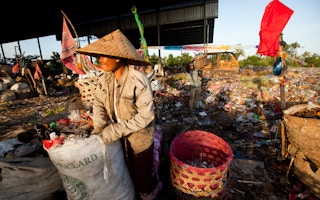In Bali, where fuel is heavily subsidised (at the risk of crippling the national budget), an elderly man cooks his rice with fuel harvested from plastic.
The cacophony of Denpasar’s traffic fades as you enter Pekambingan village, home of a self-taught inventor, Ida Bagus Ketut Atmaja.
Shade trees line the paved alley, roosters scratch inside bamboo cages and children and adults rest in the cool lent by leafy boughs overhead.
The plastic waste besieging many Balinese villages has been vanquished here. The village is clean — although its river remains choked with rubbish.
“Success to me is that we get on top of the plastic problem, that my grandchildren can play in the river as we old folk did when we were children,” says Ketut of his motivation to build an safe incinerator for plastic waste. He says he never set out to make fuel — it was a byproduct that may prove to be an unexpected reward for communities cleaning up plastic waste.
Expected hikes in gasoline prices following reduced government subsidies would make that reward even greater.
“The idea was how to deal with plastic waste — how to clean up the rivers and streets. Early information was that people were burning plastic and releasing poisonous gasses, so we tried to heat plastic waste in a different way, without open fires,” says Ketut.
“
It takes one kilogram of plastic to make a liter of fuel, so two problems are solved in a single application. Each village can have its own furnace to burn waste plastic that is not releasing pollutants, while also yielding free fuel
Ida Bagus Ketut Atmaja, Balinese self-taught inventor
The oxygen-free furnace he has been working on uses a neutral atmospheric gas to prompt combustion, allowing plastic to be burned without releasing toxic fumes.
“We saw that smoke from the plastic liquefied within the furnace and found that it could be used as a fuel, so we were keen to find a way to harvest this fuel from the waste,” says Ketut.
The device works like an arak or whiskey still. As plastic burns, gases travel down a water-cooled pipe and condense into a liquid, which drips into bottles — and can be used as fuel that has been successfully used to power motorcycles.
“It takes one kilogram of plastic to make a liter of fuel, so two problems are solved in a single application. Each village can have its own furnace to burn waste plastic that is not releasing pollutants, while also yielding free fuel,” Ketut says.
“I use this fuel for cooking every day,” he adds.
There’s been a lack of local interest to research the furnace or to certify that exhaust from the plastic-to-fuel concoction is safe, Ketut says.
While Badung regency’s environmental cleanliness department assisted in motorcycle tests of the fuel, for example, no funding has been granted to date for further study, according to Ketut.
“At the moment we don’t yet have quality results from any labs, but we can see at present we can safely burn plastic, but we are not ready to claim plastic can make an alternative to petrol,” he says.
“Our primary motive to rid areas of plastics safely has been achieved. At present the fuel aspect of the project is in limbo,” Ketut, who has self-funded the entire project, said.
Without official help and safety certifications, it will be a struggle to convince communities to invest US$500 for a furnace.
“People don’t yet see plastic as a big problem that impacts health,” Ketut says. “They are still only thinking about money. Once we see the results of emissions from this fuel, maybe more people will come on board.”
Ketut is a pioneer in introducing such technology to Bali. Similar — and safe — devices have been developed in India, Japan and the US.
According to Science Daily, researchers led by Brajendra Kumar Sharma from the University of Illinois at Urbana-Champaign in the US, for example, used a similar method to convert plastic into crude oil.
In that case, Sharma’s team mixed oil distilled from the plastic into different petroleum products, including diesel, to see if they complied with US environmental standards — which they did — as long as an anti-oxidant was added, Science Daily reported.
In Bali, Ketut still has his dream.
“If we had emissions data, people could start making their own fuel,” says Ketut of the device he has been working on since 2012 in hopes of restoring the river playground of his own childhood memories for his grandchildren.










